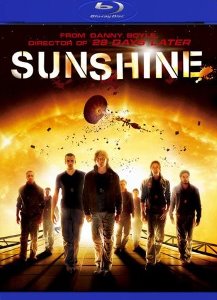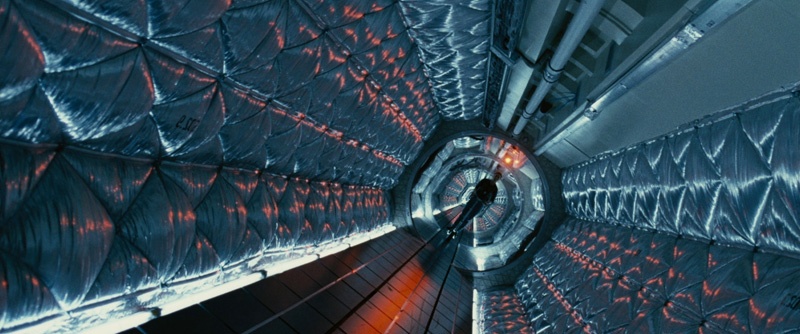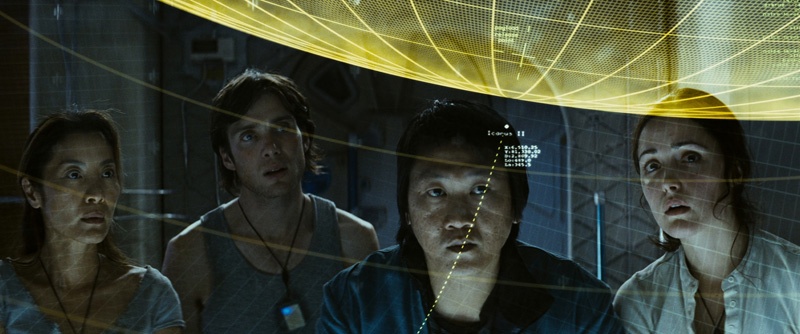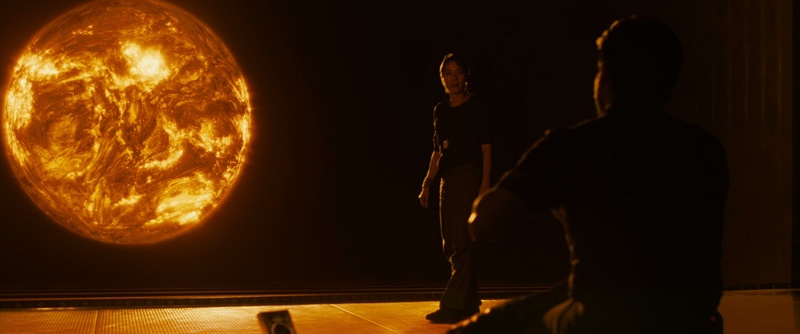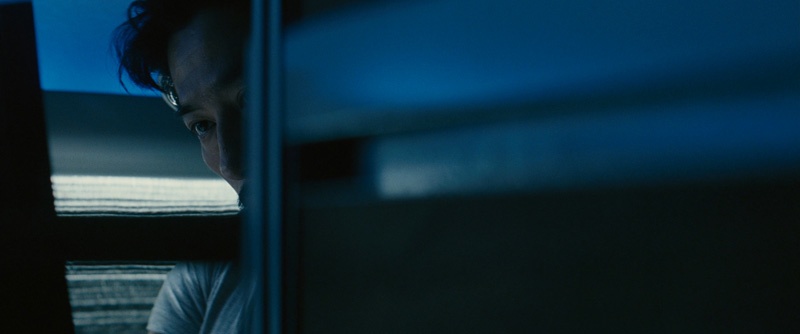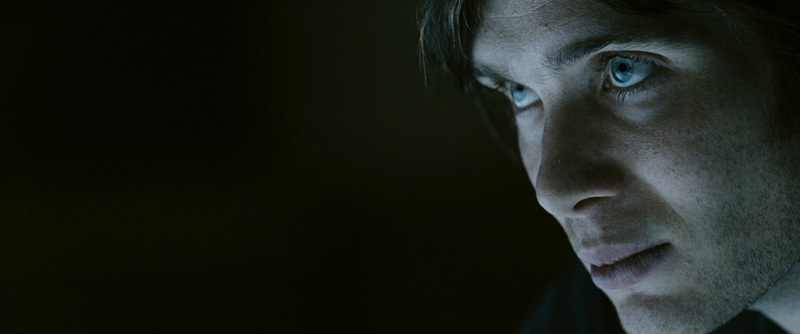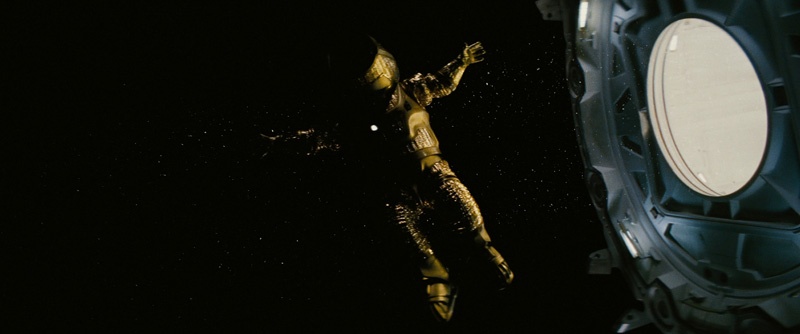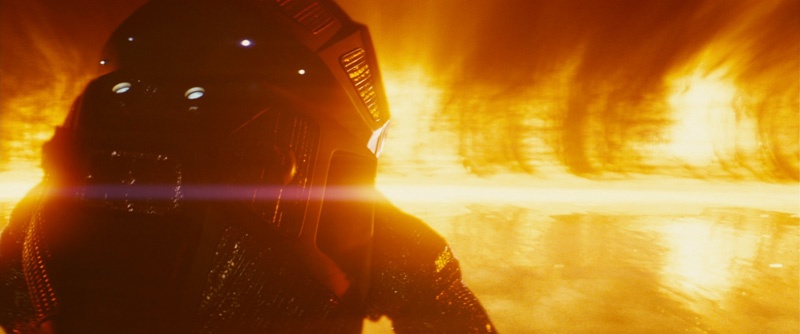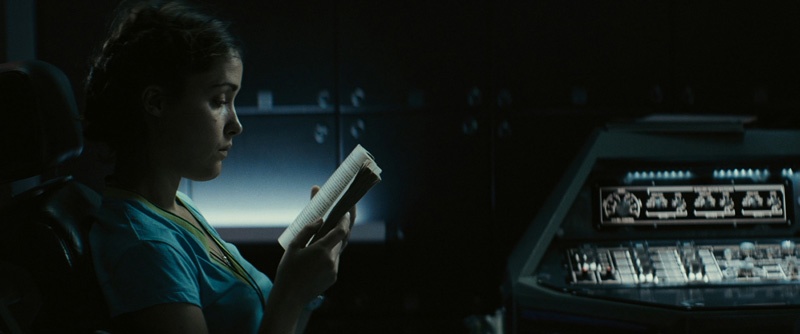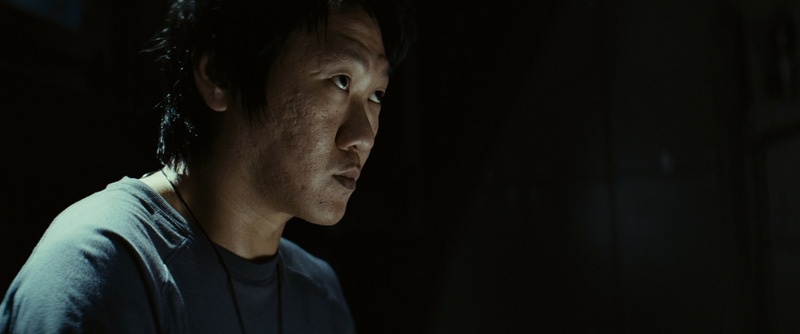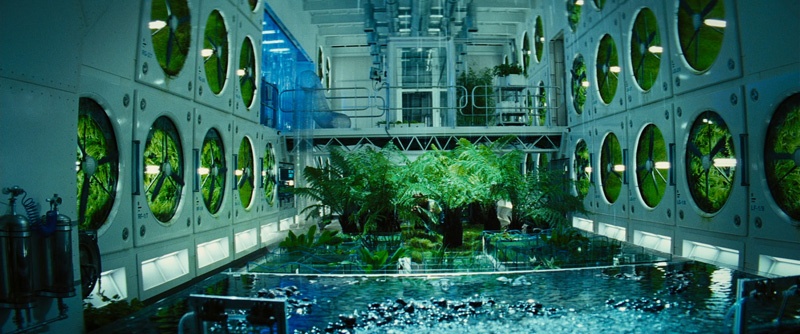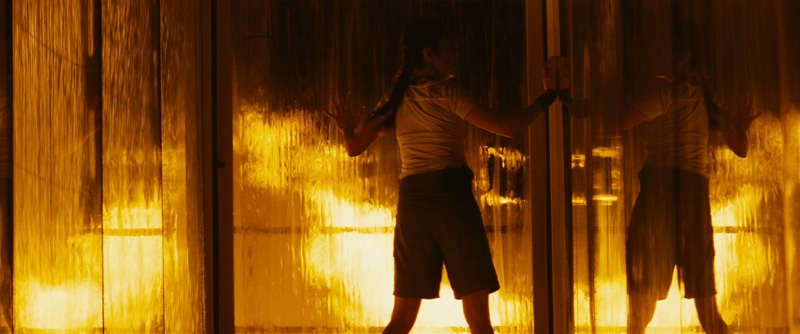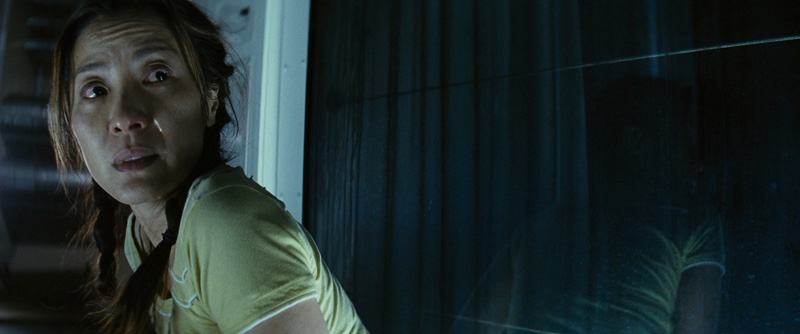Sunshine - BRD
(Danny Boyle
, 2007)
Studio:
Theatrical: Fox Searchlight Pictures (USA)
DVD: 20th Century Fox Pictures Home Entertainment
Review by Leonard Norwitz
Disc:
Region: 'A' (as verified by the Momitsu region FREE Blu-ray player)
Runtime: 1:47:27.441
Disc Size: 39,499,744,534 bytes
Feature Size: 27,128,567,808 bytes
Average Bitrate: 24.65 Mbps
Chapters: 21
Case: Standard Blu-ray case
Release date: January 8th, 2008
Video:
Aspect ratio: 2.4:1
Resolution: 1080p
Video codec: MPEG-4 AVC Video
Bitrate:
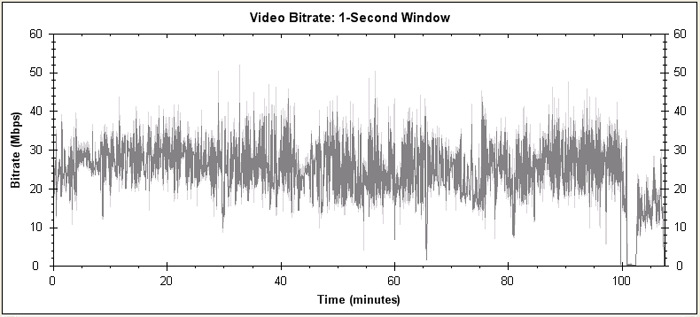 |
Audio:
DTS-HD Master Audio English 4009 kbps 5.1 / 48 kHz / 4009
kbps / 24-bit (DTS
Core: 5.1 / 48 kHz / 1509 kbps / 24-bit)
Dolby Digital Audio English 448 kbps 5.1 / 48 kHz / 448 kbps
Dolby Digital Audio English 448 kbps 5.1 / 48 kHz / 448 kbps
Dolby Digital Audio French 448 kbps 5.1 / 48 kHz / 448 kbps
Dolby Digital Audio Spanish 448 kbps 5.1 / 48 kHz / 448 kbps
Dolby Digital Audio English 224 kbps 2.0 / 48 kHz / 224 kbps
Dolby Digital Audio English 224 kbps 2.0 / 48 kHz / 224 kbps
DTS Express English 128 kbps 2.0 / 48 kHz / 128 kbps /
16-bit
Subtitles:
English, English SDH, Spanish, Chinese and Korean
Extras
• Audio Commentary by Director Danny Boyle
• Audio Commentary by Dr. Brian Cox
• 2 Short Films with Introductions by Danny Boyle
• Deleted Scenes with Optional Commentary by the Director
• Enhanced Viewing Mode* with the Filmmakers
• Journey Into Sound – Surround Sound Enhancement
• Theatrical Trailers in HD
Sunshine ~ Comment
I imagine critics find comparisons to Ridley Scott’s Alien, 2001: A Space Odyssey and perhaps Solaris inevitable – these with a dollop of Friday the 13th’s Jason thrown in to ratchet up the thrill factor. The blend works surprisingly well most of the time, despite it obvious mixed pedigrees.
Sunshine ~ The Score Card
The Movie : 7
A crew of 8 astronauts and scientists are on a mission to save our planet from a frozen future. It seems that our Sun has lost some of its heat and the Icarus II is on a several year voyage in a last ditch attempt to kick start the star into behaving like its old self again. Icarus I met with a fate unknown somewhere in the vicinity of Mercury, beyond the point where communication with Earth was no longer possible. As the film begins, Icarus II is about to enter the same zone. They send farewell greeting to loved ones back home, though they still expect or, at least hope, to be able to return. From here on in they are on their own with only the ship's computer, their youthful wisdom and their dedication to the mission to guide them. That mission is to deliver a giant nuclear payload directly onto the surface of the Sun that would, theoretically cause the necessary chain reaction. But they soon encounter a new problem – several, in fact, stemming from the discovery of the derelict Icarus I. The question is: Should they make a detour to rendezvous with what might be a dead end in the hopes of finding an operational payload to add to theirs with the risk of confronting the reason why Icarus I failed, which just might put an end to their mission as well.
ADDENDUM: I screened this movie twice, separated by 6 weeks,
both times on Blu-ray. The second time, I had several
friends over and we naturally shared our views afterward.
This time, I had a quite different journey, beginning long
before the arrival of the "fifth crewmember," the appearance
of whom had so derailed me the first time. It had seemed,
previously, that things had been going so well, so sort of
realistically up that moment, and then suddenly we found
ourselves in a quite different genre. Now I see the film as
a metaphysical examination of our uniquely human battle
between Hope and Despair, and the arrival of the fifth
crewmember as the cinematic manifestation of that despair.
From the outset, humanity's hope for survival in the face of
a dying sun lies in a gamble. The crews of both Icarus
missions are instructed to bring their payload to the
surface of the sun and there ignite the possibility of new
life. Whoa! Sounds like tampering to me. I mean, there's
Science. And there's God's will. But in this film, it isn't
so much Science that is opposition to the "natural order of
things," but Hope. Rational choices are made, but there is
no evidence, no experimentation, to have demonstrated that
our plan will succeed. When Kirk asks Spock to "make your
best guess" in The Voyage Home, and McCoy observes
that Spock's best guess is better than our certainty,
Spock's calculation is, nonetheless, a guess, a toss of the
coin, a crapshoot. If he's wrong by as much as his own
standards for error permit, they don't get home. Likewise,
for the mission of the Icarus.
Despair has always been understood in terms of Darkness;
Hope in terms of Light. The biblical God of Creation first
brings Light to Chaos, out of which Life and Order spring.
But Salvation can be found in the dark as well. Jonah is
cast into the sea and in the darkness of the great fish, he
finds his way back to his mission. The same for Jesus, who
prays alone at night in the garden to clarify his purpose
and resolve.
The voyage to the sun is necessarily made in the dark,
facing away from the sun. It is not merely the sun's gravity
that draws Icarus and its crew to it. Every
crewmember is desperate to know and understand what it means
to see the face of the sun. The crew's psychologist requires
his periodic, filtered fix of sun. Despite the artificial
light of Icarus, doubts arise, tempers flare,
mistakes are made.
Is the Sun our one true God, our birth mother, the Light of
Genesis? In any case, it is clear to director Boyle and
writer Garland that the role of the Church is to keep us in
that Dark, and that for us to rearrange the Universe
according to our needs is forbidden, like the fruit of the
Tree of Knowledge of Good & Evil, else to meet the fate of
the mythological Icarus and fly too close to the sun,
only to fall back to Earth, the wax of his wings having been
melted by the Sun – by God, if you will.
Is it God's intention that we not get too close, or only the
Church's to keep us in the Dark? Does Eco in The Name of the
Rose have the right idea about the Church's role in all
this? Paranoia is how we project our doubts and fears onto
the Other - a state of eternal confabulation. Does not
Ignorance feed paranoia? Is the Church not the ultimate
manifestation of paranoia? It is no wonder that the first
Icarus mission meets with an emissary from the Church,
which represents in this allegory: Despair in the face of
Hope? The second mission quite naturally follows the same
path, as one incident after another causes the crew to doubt
the success of the mission.
What may appear to us as thinly disguised homages, at best,
to Kubrick and Scott, are, perhaps, necessary plot devices,
just as the roles of engineer and physicist often clash in
science fiction. One of my guests last night offered that
Kubrick may have had the most pessimistic view of our future
in
2001: A Space Odyssey when he shows that progress
through evolutionary consciousness is not possible for our
species as such. For each time the monolith appears we are
advanced through the species: from ape to human to space
child. In a way, Sunshine begins with the appearance of the
monolith outside Jupiter, but with a very different purpose
and outcome. The view of Boyle and Garland is that we can
proceed through the Dark Side as long as we maintain Hope
and Courage, and that our dreams out of our better nature
are not inspired by the Church – quite the contrary - but by
our natural humanity, of which we are its sole proprietor.
We may not succeed altogether, and probably won't, but our
peculiar self-aware voyage through Life, regardless of the
roadblocks, is what makes us who we are and what makes Life
worthwhile even though we end up as dust.
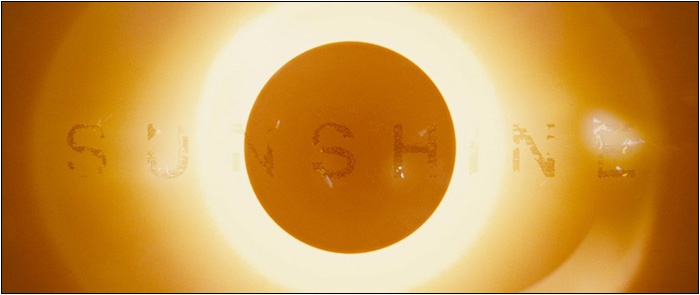 |
Image : (9/9)
NOTE: The below Blu-ray captures were ripped directly from the Blu-ray disc.
The
first number indicates a relative level of excellence
compared to other
Blu-ray
video discs on a ten-point scale. The second number places
this image along the full range of DVD and
Blu-ray
discs.
The problem for any video playback system in reproducing a
movie like this is how it handles the extreme light values.
What is required is phenomenal brilliance, but not to the
point of lack of color. Since I never saw this movie in the
theatre I can only speculate as to this BRD's probable
resemblance to same. I think this Fox
Blu-ray
delivers in this area. The darker scenes tend to show grain,
but not at all to the point of distraction. I found no
distracting transfer issues either. This
Blu-ray
is a real system buster, but you will impress you friends if
you're system is up to it.
CLICK EACH BLU-RAY CAPTURE TO SEE ALL IMAGES IN FULL 1920X1080 RESOLUTION
Audio & Music : 9/7
The audio track is very good here, with excellent reproduction of both the faintest and subterranean passages. My one complaint was that "Jason's" name is buried in the mix so that it is nearly unrecognizable. I speculate this might have been deliberate to keep us guessing until his identity is obvious. [See also Recommendation, below]
Operations : 7
The difficulty for me was how light the text appeared for some of the Extra Features (see screen captures). The scene selection menu has no chapter titles and the thumbnails don't expand much, as you can see.
Extras :
Two separate commentaries from director Boyle and Dr. Brian Cox. The "Enhanced Viewing Mode with the Filmmakers" requires a player – yes, the player, not the display - with picture-in-picture capability. Likewise, the enhanced audio feature demanded what I don't have. My bad. Sorry. The two short films are really short (about 7 minutes each) and really out there – in fair to poor 480i.
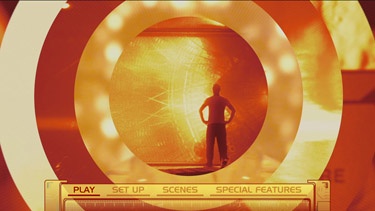 |
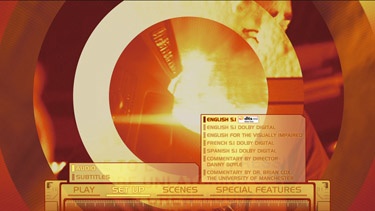 |
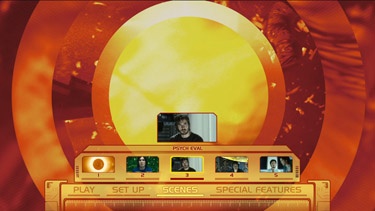 |
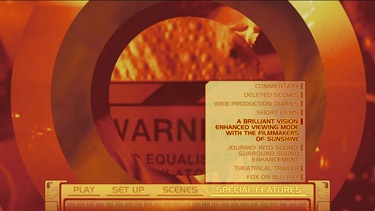 |
Recommendation: 7
I found the metaphysical discussion and its various dramatic implications intriguing, but thought that "Jason" (my quotes) was a cop-out. All the same, a great visual and sonic showpiece and worth a visit.
Leonard Norwitz
LensViews
January 5th, 2008
January 12th, 2010

